Choosing and Using Car Seats
Frequently Asked Questions
The following are frequently asked questions about choosing and using car seats. For questions about North Carolina’s Child Passenger Safety Law including what they law says about when children are allowed to face forward, use a booster seat, and use a seat belt, visit Common Questions about the NC CPS Law. For questions about “best practice recommendations” for selecting restraints, visit the “Recommendations for best protection” page.
Click on the arrows ( ) for more information.
) for more information.
Choosing Car Seats
-
- How do I find out if my car seat has been recalled?
- You should always register your car seat with the manufacturer whether on the manufacturer’s website or by mailing in the registration card that came with the seat. In the event of a recall, manufacturers are required to notify all registered users that their child restraint is included in the recall. Your contact information can only be used for safety notifications. If you have questions about the recall status of a particular seat, call the car seat manufacturer to ask about active recalls. Be prepared to give them the model number and manufacture date of your seat. This model and date information as well as a phone number for the manufacturer should be located on your seat either on a sticker or embossed into the plastic. If you cannot find the phone number for the manufacturer, find it on the “Car Seat and Vehicle Manufacturers” page.
- I was in a car crash. Do I need to replace my car seats?
- The decision to replace a car seat after a crash generally depends on the manufacturer of the car seat and the severity of the crash. Some manufacturers require that their seats be replaced if they are in any crash, regardless of severity. Other manufacturers only require that the seats be replaced after severe crashes. The best way to determine if your car seats need to be replaced is to contact the manufacturer directly and explain the circumstances of the crash. If you cannot find the phone number for the manufacturer, find it on the “Car Seat and Vehicle Manufacturers” page.
- What are options for children over 40 pounds in a vehicle with only lap belts?
- Some older vehicles may not have both lap and shoulder belts available in one or more seating positions. Options available for older children in lap-belt-only seating positions are limited because belt-positioning booster seats CANNOT be used with only a lap belt. North Carolina law allows children weighing at least 40 pounds to be restrained by a lap belt only seat belt if no seating positions with both a lap and shoulder belt are available. However, that might not be the best option.
- Today, most forward-facing child restraints with harnesses can be used for children weighing more than 40 pounds and some can be used for children up to 90 pounds. For more information on available restraints, see Car Safety Seats: A Guide for Families produced by the American Academy of Pediatrics.
- Are used child restraints okay?
- A child restraint handed down from a trusted family member or friend can be a safe option as long as the following criteria are met:
- 1. It has a label that can be read and that clearly indicates the manufacturer, model number, date of manufacture, and that it met all applicable Federal Motor Vehicle Safety Standards in effect at the time of manufacture. If there’s no label at all or if the label cannot be read, do not use the seat!
- 2. It is not expired (expiration dates are usually included on a label or are embossed into the plastic). If you can’t find the expiration date, call the manufacturer to confirm that the seat is not expired.
- 3. The complete instruction manual is with the seat or can be obtained from the manufacturer.
- 4. All the parts are included (check in the instruction manual) or can be obtained from the manufacturer before the seat is used.
- 5. It has never been used in a crash. Even if a seat has no visible damage it still may not be safe to use.
- 6. It is not under recall or that corrections have been made if it was recalled. Refer to “How do I find out if my car seat has been recalled?” above.
- If you can’t satisfy these requirements, you are taking a big risk by using the child restraint and the best advice is to not use that seat.
- We do not recommend using seats purchased from consignment shops, yard sales, or online used shopping sites because it is difficult to verify that the seat has never been used in a crash.
- Is any model of seat or type of harness escape-proof?
- Not completely. Some children seem to be able to get out of anything. This usually occurs during the natural stage when they are becoming more active and independent and learning to manipulate things with their hands.
- What can you do? If you are buying a seat, look for one with a buckle that is very hard for a child to reach and undo. Always keep the harness system adjusted for a snug fit and use the harness clip at the child’s armpit level.
- Be patient, firm and consistent, and make sure your child knows that the car doesn’t go unless everyone is in their seats. If your child manages to get out of his seat while the vehicle is moving, pull over to a safe spot and redo the harness.
- Positive reinforcement is crucial, such as small rewards for good behavior (stickers, small toys, trips to the playground, or whatever else will motivate your child). Other ideas that may help are short “training” trips to favorite spots like a playground where the child is rewarded with playground time if he stays buckled the whole time and is not allowed to play if he unbuckles during the ride, dramatic play in which the child buckles up a favorite doll or stuffed animal for a real or pretend car ride, or distractions like soft toys or music that are only allowed in the car.
- You must be prepared to enforce your rules on every trip. Parents have to be aware that they may be in a battle over this issue, and it can last for several weeks, but it is one that must be fought and won by the parents.
- If it continues to be an issue, you may find it helpful to consult with a pediatrician or a child psychologist to come up with a behavior modification plan that will work best for your child.
- My child has special healthcare needs. Do I need a special car seat?
- In many cases a conventional car seat will meet the needs of a child with special physical and/or developmental needs. Car seats come in many different shapes and sizes so even if your current seat no longer works for your child, there may be another conventional car seat available that will work. However there are some situations where a specially designed car seat is necessary.
- If you have specific questions about your child’s needs email info@buckleupnc.org to reach an expert on the transportation of children with special healthcare needs.
- How do I find out if my car seat has been recalled?
Using Car Seats
-
-
-
- Note: The vehicle and car seat owner’s manuals provide the most accurate information on how to correctly use and install your car seat in your vehicle. For specific questions about your car seat, consult the car seat instructions, contact the manufacturer, and/or visit a local car seat checking station for hands-on assistance.
-
-
-
- Where should I install my car seat in my vehicle?
- In general, the safest position in the car is the location where the car seat can be installed and used correctly every time. Car seats should be installed in the back seat in vehicles that have a back seat. In pickup trucks or other vehicles without a back seat, car seats can be installed in the front passenger seat. However, rear-facing seats can NEVER be installed in front of an active airbag. Rear-facing seats can only be installed in the front seat of small pickup trucks or other vehicles without a back seat if the airbag is turned off. It is extremely dangerous to put a rear-facing car seat in front of an active airbag.
- All other things being equal, the center rear seat is generally considered to be the safest seat in a car because it is the farthest seat from any potential impact. However, the side seats also provide good protection as long as the car seat is installed and used correctly. Keep in mind that many vehicles do not allow the use of lower LATCH attachments in the center rear position. Consult your vehicle owner’s manual to determine which seating positions allow use of lower LATCH attachments.
- Should I install my car seat using the seatbelt or LATCH?
- The seatbelt and LATCH are both equally safe options provided they are used correctly. Not all vehicle seats allow use of LATCH so be sure to consult your vehicle owner’s manual to determine which seats have lower LATCH and tether anchors.
- LATCH anchors do have an upper weight limits that should be specified in your vehicle owner’s manual. Once a child reaches the LATCH anchor weight limit, you must discontinue use of the lower LATCH attachments and instead install the car seat using the seatbelt.
- Most vehicle and car seat manufacturers allow installation with either the LATCH lower anchors or the seatbelt, but not both. However, there are some that do allow the use of both the lower anchors and the seatbelt. Consult your vehicle and car seat owner’s manuals to see if using both is allowed.
- For more information on when to use the top tether, see the “What is the top tether and when do I use it?” question below.
- Learn more about Top Tether connections
- Where can I go to make sure my child restraint is installed properly?
- Permanent Checking Stations are locations where parents and other caregivers can meet with a Certified Child Passenger Safety Technician to make sure their child restraint is installed correctly. To find a station near you click here.
- What is LATCH?
- LATCH stands for Lower Anchors and Tethers for Children and is a system for installing child restraints in vehicles. The intent of LATCH is to simplify car seat installations. In the vehicle, a complete LATCH system consists of two lower anchors and one upper anchor. Each lower anchor is a rigid bar located where the vehicle seat cushion meets the seat back. The upper tether anchor is permanently attached to the vehicle at the top of the rear seat or some other location behind the vehicle seat. On car seats, LATCH consists of 2 lower attachments (either flexible or rigid) and a top tether strap (not present on rear-facing only seats).
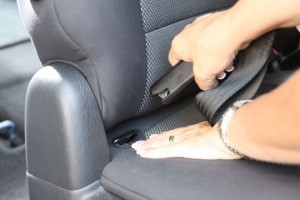
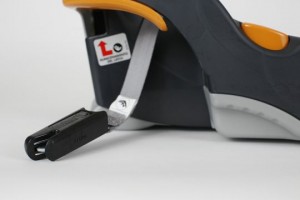
- Left: Connecting the LATCH attachment to the LATCH anchor
Right: LATCH attachment on a rear-facing only car seat
Photo Credit: NHTSA 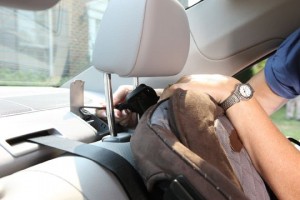
- Connecting the Top Tether to the Tether Anchor
Photo Credit: NHTSA
- These LATCH requirements have applied to all model year 2003 cars, minivans, and pick-up trucks, but many vehicles were equipped with LATCH before that date. Consult your vehicle owner’s manual to determine which seats have LATCH. LATCH does have a weight limit after which the seatbelt should be used for installing car seats. Consult your vehicle owner’s manual to determine the LATCH weight limit in your vehicle.
- What is a top tether and when do I use it?
- A top tether is a strap connected to the top of the car seat that attaches to a designated anchor mounted in the vehicle. Forward-facing car seats installed with top tethers provide much better crash protection than those without tethers, so it is important to use top tethers for all forward-facing seats, even those installed using a seat belt. Top tether anchor locations vary by vehicle so consult your vehicle owner’s manual to determine the designated locations in your vehicle. Only use designated anchor locations to attach your child restraint’s top tether. A properly used top tether strap hooked to a tether anchor can help keep any forward-facing child restraint more secure.
- Top tethers can be used regardless of if the child restraint is installed using the vehicle belt system or the LATCH lower anchors. In general, top tethers are used for forward-facing child restraints however a few manufacturers allow the use of a tether for their rear-facing seats. Consult your car seat owner’s manual to determine the recommended use of tethers for your car seat.
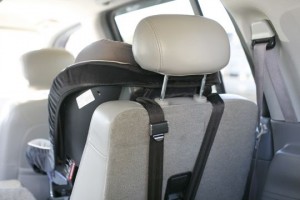
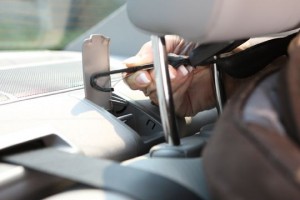
- Left: Top Tether in use in a minivan
Right: Attaching the top tether in a sedan
Photo Credit: NHTSA
- Where should I install my car seat in my vehicle?



